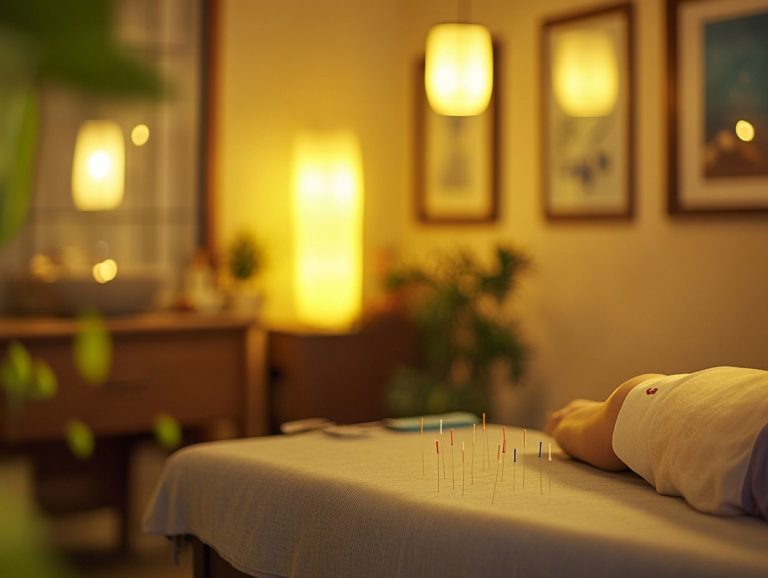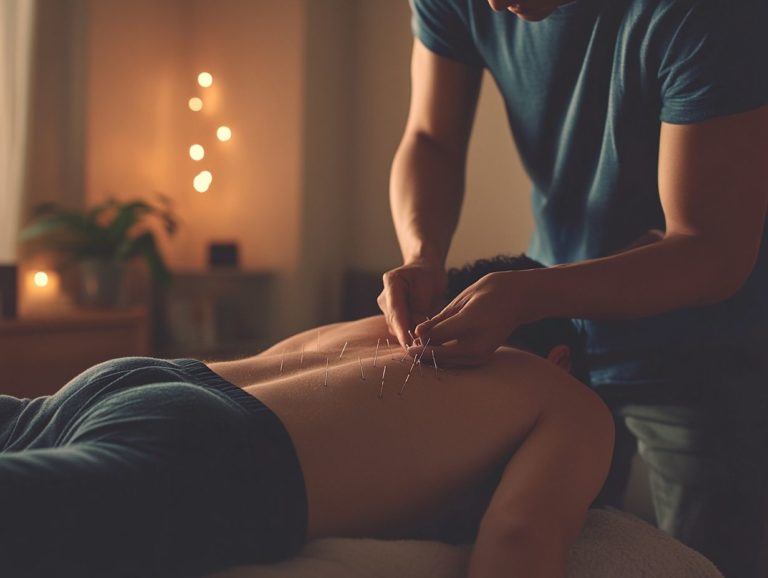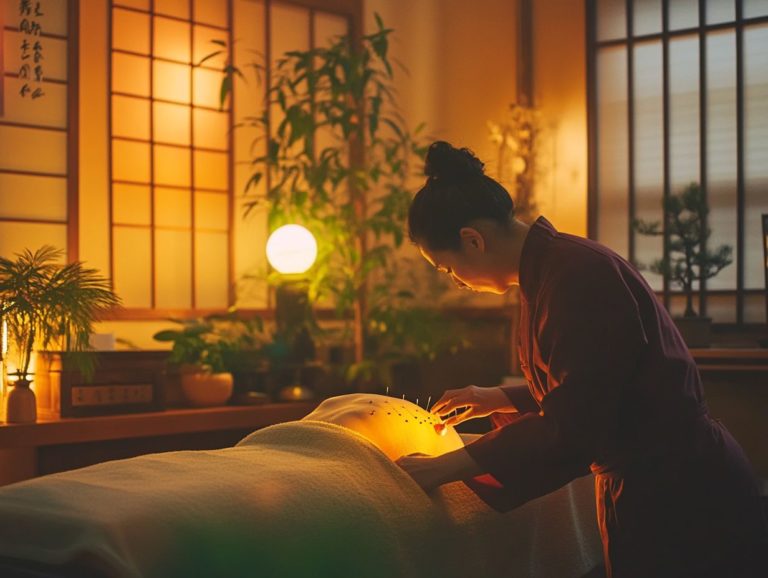5 Acupuncture Techniques for a Healthier Lifestyle
Acupuncture, a cornerstone of Traditional Chinese Medicine (TCM), provides a holistic approach to health that goes beyond simple pain relief.
In this exploration, you ll delve into five distinct acupuncture techniques Traditional Chinese Medicine, Electroacupuncture, Auricular Acupuncture, Moxibustion, and Cupping Therapy each offering its unique benefits and applications.
The article also highlights the core principles of acupuncture, its advantages for various health concerns, potential side effects, and practical ways to weave it into your lifestyle.
Uncover how these ancient practices can elevate your well-being today!
Contents
Key Takeaways:
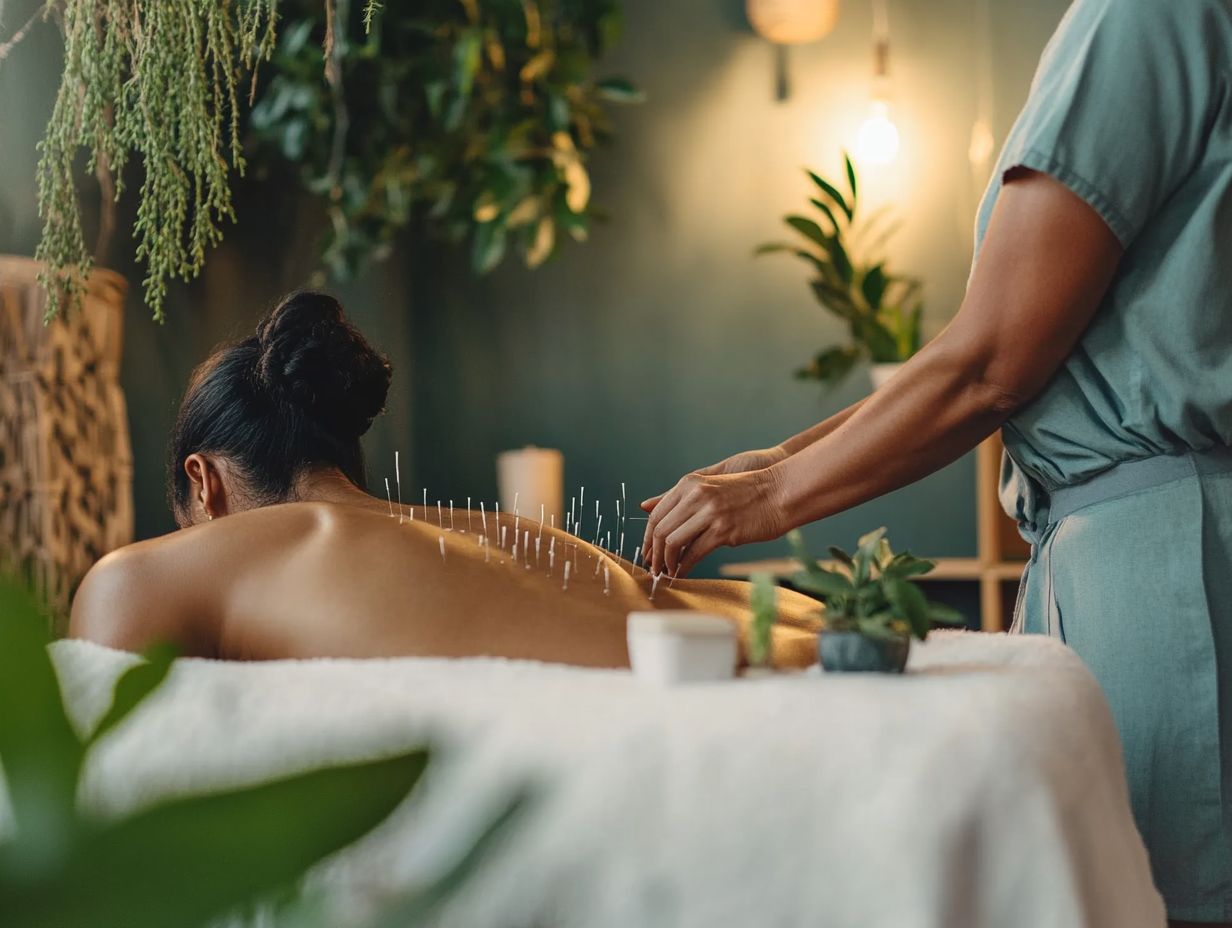
Traditional Chinese Medicine (TCM) focuses on balancing energy flow in the body for overall health and wellness.
Electroacupuncture adds gentle electrical stimulation, enhancing traditional techniques for effective pain relief.
Auricular acupuncture targets acupressure points in the ear, addressing both mental and physical health issues.
1. Traditional Chinese Medicine (TCM)
Traditional Chinese Medicine (TCM) is an ancient practice offering various treatments, including acupuncture. These methods aim to balance your body s energy, known as qi, to promote health.
This approach emphasizes harmony within yourself, using natural therapies to effectively target chronic conditions.
Qi is often described as your life force, flowing through pathways called meridians. Think of meridians as rivers that carry this energy, ensuring your well-being.
In acupuncture, practitioners stimulate specific points along these pathways. This restores balance and alleviates various ailments.
The process not only addresses physical challenges but also fosters mental clarity and emotional strength.
Choosing a certified acupuncturist is vital. Their expertise can significantly enhance your well-being and may help you discover 5 ways acupuncture can enhance your yoga practice.
2. Electroacupuncture
Electroacupuncture offers a modern twist on traditional acupuncture. It uses electric stimulation to enhance pain relief and reduce muscle tension.
By combining gentle electrical currents with precise needle placement at acupressure points, this technique boosts blood flow and stimulates energy pathways, known as meridians.
This targeted approach allows practitioners to focus on specific discomfort areas more effectively than standard acupuncture. As a result, patients often experience quicker recovery and improved health.
Many notice a faster reduction in symptoms, as electrical impulses promote deeper muscle relaxation and better circulation, enhancing the body’s natural healing abilities.
3. Auricular Acupuncture
Auricular acupuncture is a unique technique that stimulates acupressure points in your earlobes. It effectively addresses anxiety, depression, and energy imbalances.
This method, rooted in traditional Chinese medicine, connects your ears to various organs and emotional states. It benefits both mental health and physical issues, such as chronic pain and allergies.
Integrating auricular acupuncture into your treatment plan, alongside therapies like cognitive-behavioral therapy, can enhance mental resilience and promote relaxation.
This holistic approach emphasizes the connection between your mind and body, paving a path to better health.
4. Moxibustion

Moxibustion is a time-honored technique in traditional Chinese medicine that involves burning mugwort to stimulate acupuncture points. It is particularly useful for enhancing immune support and promoting healing in chronic conditions.
This ancient practice complements acupuncture and plays a crucial role in therapy. Practitioners aim to invigorate the flow of energy, or Qi (pronounced ‘chee’), throughout your body.
Mugwort is celebrated for its anti-inflammatory properties. It is believed to aid digestion, alleviate fatigue, and boost overall vitality.
The warmth generated from burning this herb penetrates deeper layers of your skin, creating an environment that nurtures healing and wellness. By combining these methods, you can enhance therapeutic outcomes, especially when dealing with digestive issues or chronic exhaustion.
5. Cupping Therapy
Cupping therapy is an exceptional physical wellness treatment that employs suction cups to relieve muscle tension and enhance blood flow. It also alleviates chronic pain, making it a favored complement to acupuncture.
This technique creates a vacuum effect on the skin, drawing out toxins and encouraging the flow of stagnant energy. It offers significant benefits for those grappling with sports-related injuries or stress.
Athletes frequently embrace this method to accelerate healing by improving circulation and promoting muscle recovery. Ultimately, this leads to enhanced performance.
The synergy of cupping and acupuncture profoundly reduces stress levels. Both techniques target specific points on the body linked to relaxation and overall well-being, addressing physical ailments while nurturing a deeper sense of balance and health.
What Is Acupuncture and How Does It Work?
Acupuncture serves as a cornerstone of traditional Chinese medicine. Fine needles are artfully inserted into specific acupressure points to facilitate the flow of energy. This addresses a range of health conditions, from chronic pain to anxiety, while also providing vital support to the nervous system. Many busy professionals can benefit from this practice, as highlighted in the article on the 5 benefits of acupuncture for busy professionals.
Rooted in the belief that health hinges on a balanced flow of energy through the body s meridians, acupuncture offers a holistic approach to well-being. Placing needles at key points stimulates your nervous system, prompting the release of neurotransmitters and hormones that promote natural healing processes.
The physiological effects are noteworthy. Acupuncture often results in decreased inflammation, improved circulation, and enhanced relaxation. This makes it not just a remedy for pain, but a pathway to overall wellness.
Experience the transformative benefits of regular acupuncture sessions to elevate your quality of life today! Many individuals find that these sessions effectively address both physical discomfort and emotional hurdles.
What Are the Key Principles of Acupuncture?
The key principles of acupuncture hinge on the concept of qi, the vital energy believed to flow through the body s meridians. Achieving balance in this energy is essential for optimal health and wellness.
Understanding how this life force interacts with your body s various systems is fundamental to traditional Chinese medicine. Each meridian corresponds to specific organ functions, weaving a dynamic web of connections crucial for maintaining harmony.
When blockages disrupt the flow of qi, you may grapple with various health issues, from chronic pain to emotional distress. Acupuncturists assess these imbalances by evaluating the signals your body sends, utilizing techniques like pulse diagnosis and tongue examination.
Based on these insights, they craft personalized treatment plans designed to unblock pathways, restore equilibrium, and foster holistic healing.
What Are the Benefits of Acupuncture?
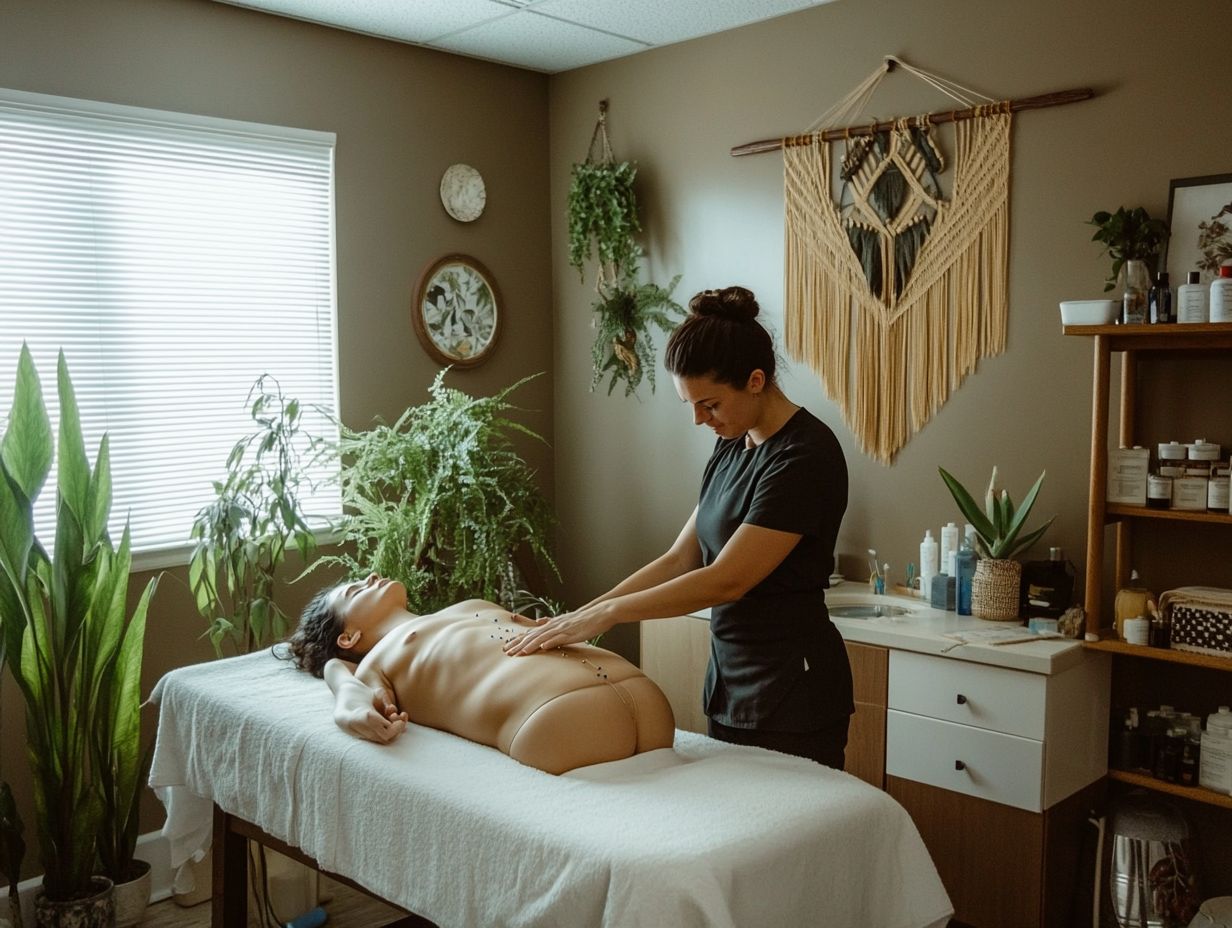
Acupuncture presents a wealth of health benefits, including effective pain relief, better immune support, and significant stress alleviation. For those looking for additional methods, exploring energy healing techniques for stress relief can also be a versatile treatment option for various chronic conditions.
In addition to these advantages, you may notice positive effects on your mental health, particularly in alleviating anxiety and depression. Research shows that acupuncture helps regulate neurotransmitters, contributing to an improved mood and greater emotional stability.
Furthermore, studies suggest acupuncture can effectively address digestive issues, offering relief from conditions like irritable bowel syndrome and promoting overall gut health.
Numerous testimonials from individuals who have experienced acupuncture treatments reveal not only the physical relief they attained but also a remarkable enhancement in their mental well-being. This underscores the holistic benefits of this ancient therapy.
How Can Acupuncture Help with Specific Health Conditions?
Acupuncture effectively treats specific health conditions like chronic pain, allergies, and digestive health while enhancing your overall immune system function. Additionally, there are 5 ways acupuncture can help with stress relief, making this traditional practice a holistic approach to wellness.
By employing fine needles placed precisely across your body, acupuncture aims to balance the flow of energy and activate your body’s natural healing mechanisms.
If you’re grappling with chronic pain, you may experience relief as acupuncture not only tackles symptoms but also addresses underlying issues like inflammation or muscle tension. Those suffering from allergies might find that treatments enhance respiratory function and lower histamine levels.
Personalized treatment plans can target digestive concerns, promoting improved gut health and metabolism. This nurtures a more resilient immune system. With these tailored approaches, acupuncture can play a significant role in your overall health journey.
What Are the Possible Side Effects of Acupuncture?
Acupuncture is generally regarded as a safe treatment, yet it’s essential to be aware of potential side effects. Consulting a qualified healthcare professional is key.
Some individuals might notice minor bruising or soreness at the needle insertion sites. While this can be unsettling, it usually resolves quickly.
Choosing an experienced acupuncturist who employs proper techniques can significantly mitigate the risk of these side effects. A thorough health assessment before your treatment is vital.
This helps the practitioner customize your session to your unique needs and conditions, ultimately enhancing your overall experience and minimizing any discomfort that may arise during the process.
How Can One Incorporate Acupuncture into Their Lifestyle?
Incorporating acupuncture into your lifestyle can significantly enhance your overall wellness. To make the most of your sessions, consider these tips for a successful acupuncture experience, which can improve your mental health and alleviate physical issues through regular wellness visits and tailored treatment plans.
To truly benefit from this ancient practice, consider making it a consistent part of your health routine. By scheduling regular sessions, you’ll cultivate a deeper connection with your body s needs.
It’s essential to stay mindful of your personal health goals, whether focused on stress relief, improved digestion, or boosting energy levels. This thoughtful approach allows for personalized treatments, ensuring each session aligns with your evolving wellness journey.
Frequently Asked Questions
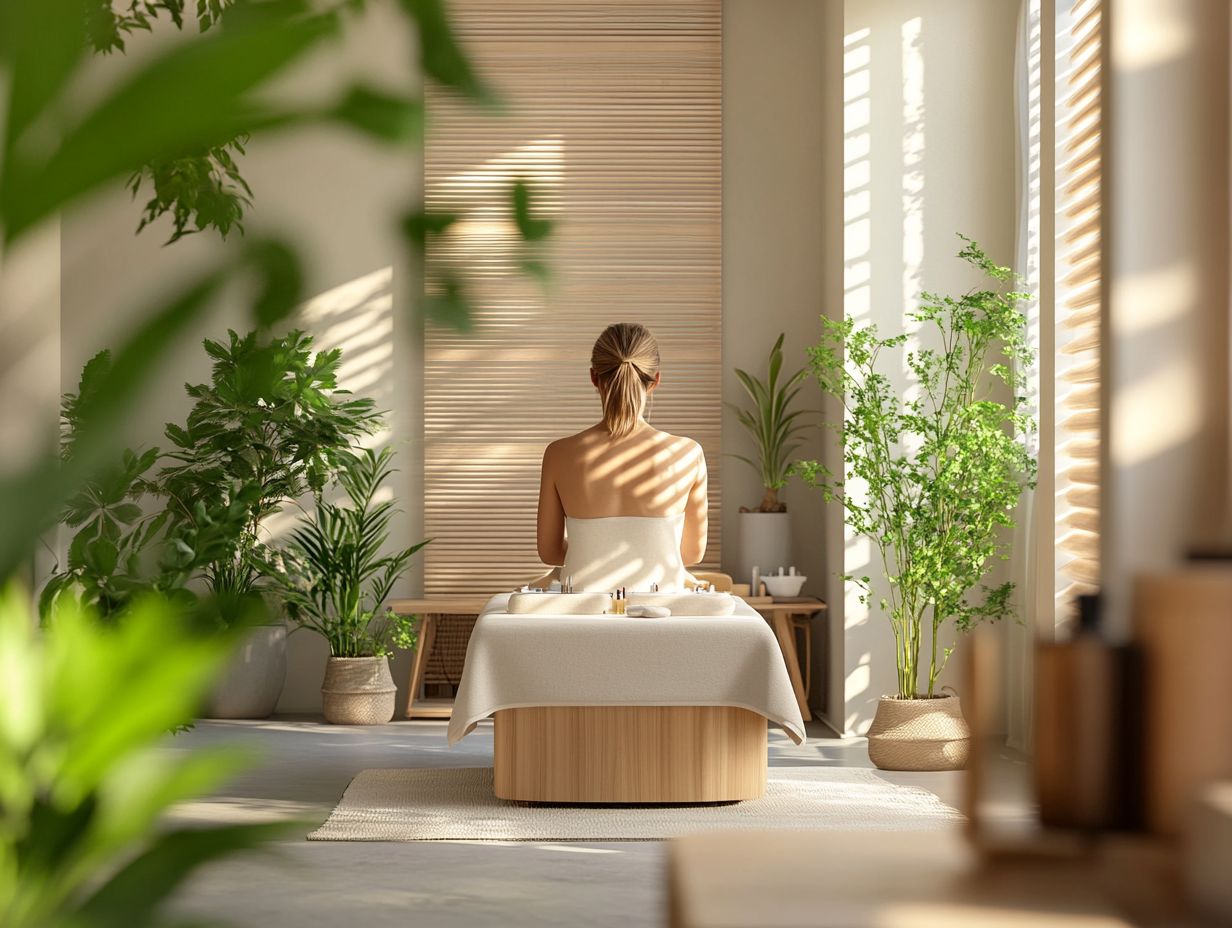
What are the 5 acupuncture techniques for a healthier lifestyle?
The 5 popular acupuncture techniques for a healthier lifestyle include traditional Chinese acupuncture, auricular acupuncture, electroacupuncture, cupping therapy, and moxibustion.
How does traditional Chinese acupuncture work?
Traditional Chinese acupuncture involves inserting thin needles into specific points on the body to stimulate the flow of energy, or “qi,” through the body’s meridians. This practice can be particularly beneficial, as highlighted in 5 ways acupuncture can improve your mood, helping to restore balance and promote overall health and wellness.
What is Auricular Acupuncture?
Auricular acupuncture uses needles on specific points in the ear. This method targets health issues effectively.
How is Electroacupuncture Different?
Electroacupuncture involves small electric currents with the needles. This boosts treatment effects for certain conditions!
What is Cupping Therapy?
Cupping therapy uses special cups on the skin to create suction. This helps relieve muscle tension and improves circulation!
What is Moxibustion?
Moxibustion burns dried mugwort near acupuncture points. This technique boosts energy flow and promotes healing.


